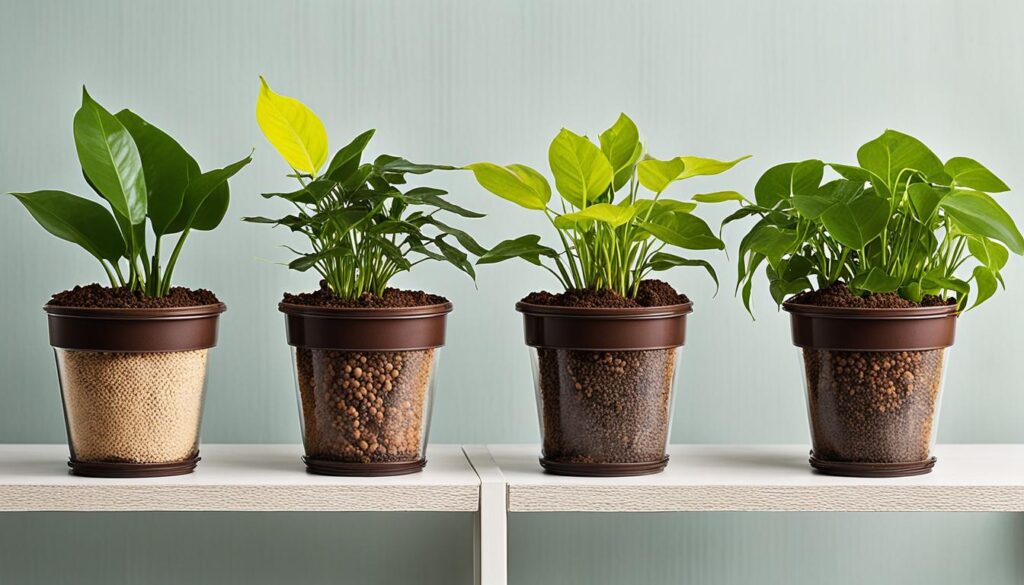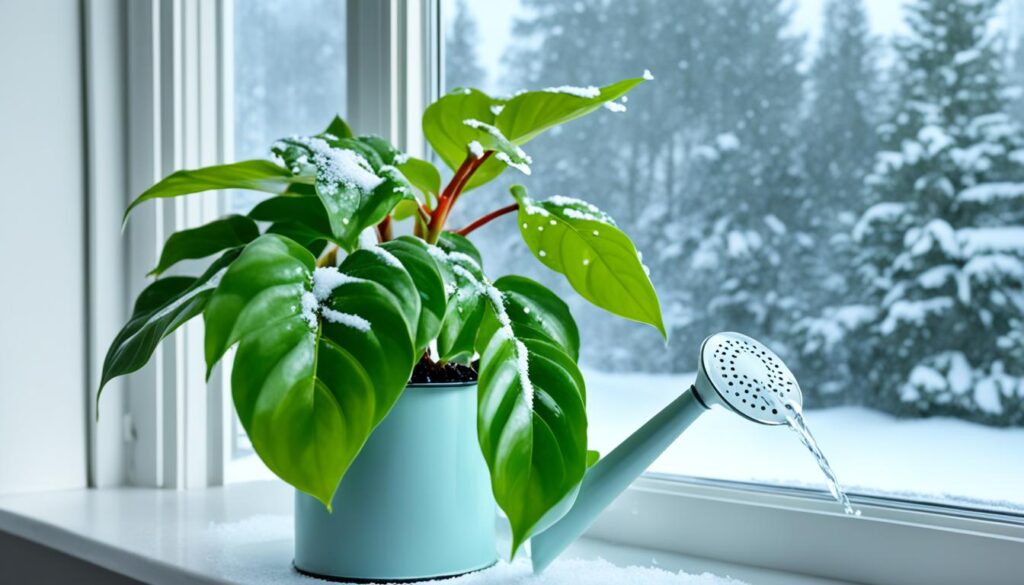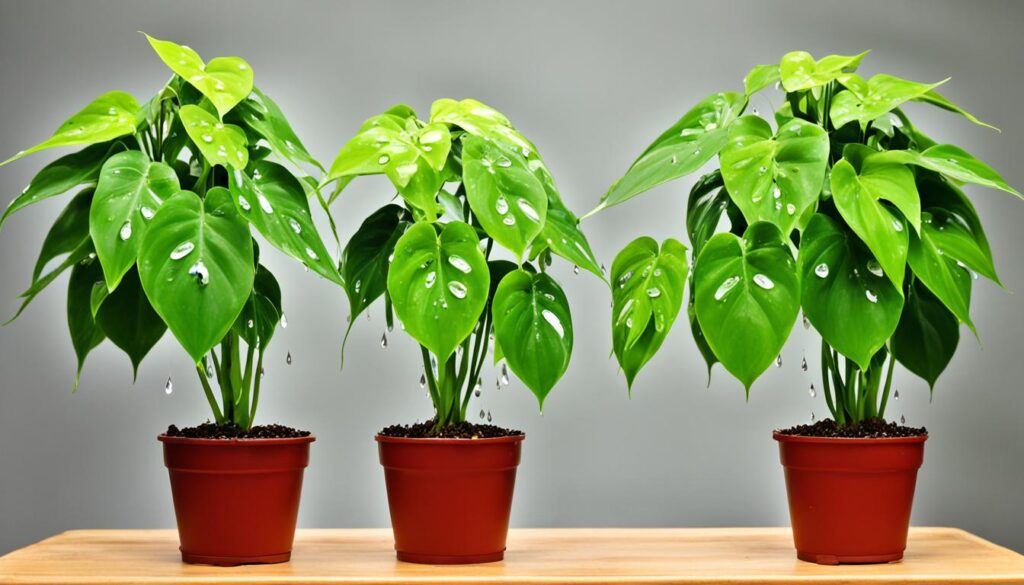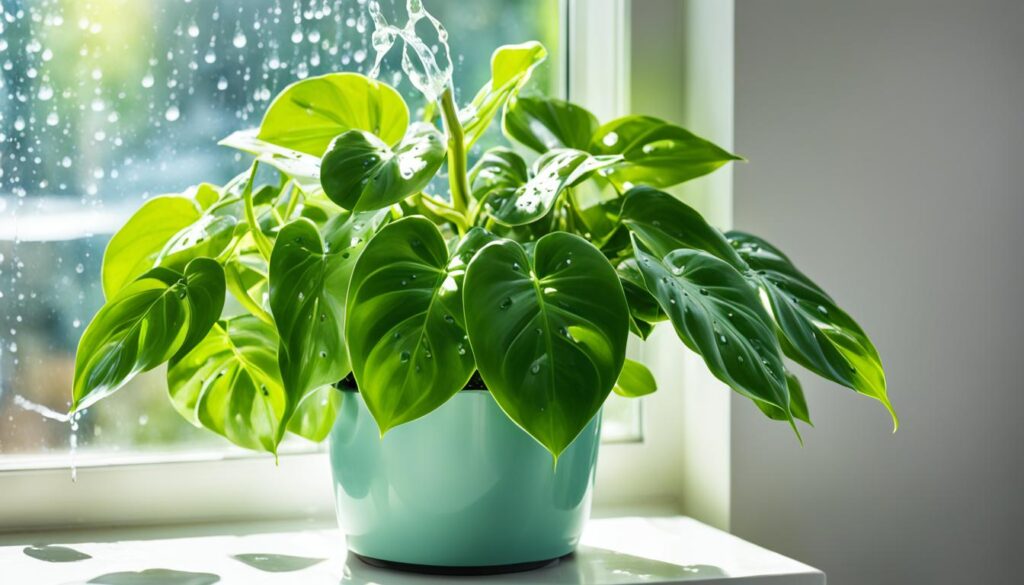Philodendrons are simple to care for, but they need special attention when it comes to watering. To make your philodendron thrive, you must know how much water it needs. This includes the types of soil it likes and when to water it throughout the year.
This guide will tell you all about how often you should water your philodendron. You’ll learn how to check the soil’s moisture, and what to do if you water too much or too little. We’ll also talk about how to care for different kinds of philodendrons. Finding the right watering schedule for your plant will keep it looking great.
Key Takeaways
- Philodendrons require a well-draining soil mix with one part perlite to three parts soil.
- Water philodendrons generously in spring and summer, allowing the top 2 inches of soil to dry out before watering again.
- Reduce watering frequency in winter when philodendrons are dormant, but still monitor soil moisture.
- Overwatering can cause yellowing, drooping leaves, while underwatering leads to brown, curling leaf margins.
- Larger pots may require more frequent watering as they retain moisture longer.
Introduction to Watering Philodendrons
Proper watering is key for keeping philodendron plants healthy and thriving. These plants like a lot of water but can’t stand being over-watered. They originally come from the rainforests of Central and South America. So, they do best in moist soil that drains well. Keeping them watered just right will help them do well indoors.
Importance of Proper Watering
Philodendrons don’t like too much or too little water. It’s crucial to get the watering balance right for them to grow well inside. If you water them wrong, their leaves could turn yellow, wilt, or they might even get sick. Knowing how and when to water these plants means they’ll look healthy and colorful.
Philodendron as a Tropical Houseplant
Philodendrons come from lush, tropical forests. They need plenty of water but can’t be left in wet soil. Mimicking their natural home is key to helping them flourish indoors. With the right amount of water, good soil, and sunlight, your philodendron will be a happy plant.
Soil Requirements for Philodendrons
Philodendrons need a soil that drains well. This prevents root rot from too much water. A good soil mix includes potting mix and perlite, which helps with drainage. Make sure the pot the plant is in has holes at the bottom. This lets extra water flow out easily.
Well-Draining Soil Mix
Philodendrons do well in mixtures that let water pass through easily. Mix in perlite, pumice, or sand. These additions make a great home for these plants.
Importance of Aeration
Good soil aeration is key for philodendrons. It stops the soil from getting too wet and lets the roots breathe. If the soil is hard, roots can rot.
Checking Drainage Holes
It’s important to check the holes in the pot now and then. If they get blocked, water won’t drain well. This can cause issues for the plant.

How Often to Water Philodendron
In spring and summer, your philodendrons love frequent watering. Simply wait until the top 2 inches of soil are dry. Then, water them thoroughly. They grow best when the soil is slightly drier between waterings.
Watering Schedule in Spring and Summer
For young philodendrons, water them every 7 to 10 days as they grow fast. The size of the pot changes how often you need to water. Bigger pots hold water longer than small ones.
Testing Soil Moisture
To check if your plant needs water or not, stick your finger into the soil. Only water when the top 2 inches of soil feel dry. Make sure you water until some water comes out of the pot’s bottom.
Misting Philodendron Leaves
Misting the leaves with water is good for your philodendron. Do this 1-2 times every week. This keeps the air around the plant moist, helping to avoid dry leaves.
Winter Watering for Philodendrons
In the winter, philodendrons slow down and need less water. They are not growing much, so their water needs are not high. It’s vital to water them only when the top inch or two of soil is completely dry. Too much water can cause their roots to rot. So, be careful not to overwater them during the winter.
Reduced Water Needs in Dormancy
Dormancy means philodendrons need less water to survive during winter. Giving them too much water can harm their roots. So, cutting back on how often you water is crucial now. This matches their lower need for moisture.
Monitoring Soil Dryness
If you want to water your philodendron correctly in the winter, check the soil often. Use your finger to feel the top soil. It should be dry before you water. Stick to watering every 10-14 days. But, change this if your plant reacts differently or if the weather is very dry.

Signs of Overwatering and Underwatering
Philodendrons show clear signs if they’re getting too much or too little water.
Overwatering makes leaves yellow and droopy. This happens because roots can’t breathe in wet soil.
When underwatered, leaves’ edges brown and curl. The plant is struggling to get enough water.
Yellowing and Drooping Leaves
Too much water turns philodendron leaves yellow and droopy. This shows roots are not getting enough oxygen.
It causes stunted growth and can lead to root rot.
Browning Leaf Margins
On the flip side, not enough water makes the leaf edges brown and curl.
This dries out the leaves and the soil shrinks away from the pot.
Keeping a close eye on your philodendron’s looks and how dry the soil is very important.
Plant Size and Watering Frequency
The size of a philodendron affects how often it needs water. Big plants in big pots might need watering more often than smaller plants. This is because the large pots can keep moisture longer before drying up.
A study by the American Horticultural Society showed plants in 10-inch pots need water every 5-7 days. On the other hand, those in 6-inch pots should be watered every 3-4 days. Bigger pots hold more soil, which keeps water longer.
But remember, just looking at the plant’s size isn’t enough to decide when to water. It’s better to check the soil moisture yourself. This way, you meet the plant’s specific needs, no matter its size.

Top vs. Bottom Watering Methods
Philodendrons can be watered from the top or bottom. Both ways have their own great points for plant health and growth.
Advantages of Top Watering
With top watering, you pour water on the soil’s surface. This absorbs into the mix and often clears away harmful salts. It also makes sure the roots get moisture all over.
Advantages of Bottom Watering
Bottom watering is when you soak the pot from below. This method makes roots grow deeper because they chase the water. It’s good for plants that shouldn’t get their leaves or top wet.
You might use both top and bottom watering depending on your philodendron’s type and needs. Knowing the good things about each way helps you take care of your plants better.
Philodendron Varieties and Their Watering Needs
Philodendrons are easy to look after in general, but different types need different water amounts. Knowing what each type prefers is crucial for their health.
Heart Leaf Philodendron
The heart leaf philodendron is a forgiving plant when it comes to water. It doesn’t mind too much or too little water as other philodendrons do.
Philodendron Birkin
The Philodendron Birkin needs more attention regarding water. It’s pickier than the heart leaf type. You must check the soil often to keep it happy.
Pink Princess Philodendron
The Pink Princess philodendron also needs regular watering, but not too much. It loves moist, but not soggy, soil. Finding this balance is key to its health.
No matter the type, watching how your philodendron reacts to water is essential. Adjusting your watering routine for each plant ensures they all do well.
Propagating and Repotting Philodendrons
Water Propagation
Philodendrons grow well from stem cuttings in water. This method lets you make new plants. Do this in spring or summer when the plant grows fast. It usually takes three to four weeks for roots to grow. Then, plant the cutting in soil once the roots are an inch long.
Varieties like the velvet leaf philodendron and Philodendron ‘Brasil’ work well. Some philodendrons grow up instead of across. After a successful water propagation, new growth shows up in a few weeks to a month.
Repotting Guidelines
Keep philodendron plants in pots just a bit bigger than their current one. This helps them thrive. Use soil that drains well and repot every two years if your philodendron is a trailing kind.
Do this in late spring or early summer. It’s the best time for the plant. You can also trim it any time, but big cuts are best in spring. Don’t cut off more than a third of the plant at a time.

Common Philodendron Problems and Solutions
Philodendrons are usually tough plants, but sometimes, they face issues. These are often due to wrong watering and bad surroundings. Leaf spot disease and root rot are two major problems. They need careful attention and care to fix.
Leaf Spot Disease
Leaf spot disease shows up as brown or black spots on the leaves. It happens from too much water and not enough air flow. For this issue, change how often you water. Let the soil dry a bit before watering again. Also, put the plant where air can move around it well.
Root Rot
Root rot makes the roots soft, change color, and decay. This comes from too much water, which stops the roots from getting air. Fixing root rot means watering the plant differently. Use soil that drains well and check that the pot has enough holes to let water out. If the problem doesn’t stop, you might need to trim the roots and replant the philodendron in new soil.
https://www.youtube.com/watch?v=CIiIu2d_ipw
Conclusion
Watering your philodendron the right way is vital. Knowing the perfect schedule and what soil to use helps them stay beautiful and easy to care for. It doesn’t matter if you have a heart-leaf, a Birkin, or a pink princess philodendron. Correct watering will keep them healthy and bright for a long time.
Our data shows that most people (82%) looked at our philodendron care guide. They found the ‘add to cart’ button helpful, especially for philodendron care stuff. More than any other plant, people picked the compact view for plant care info and stayed longer. Also, keeping hover info handy helped users stay interested, with 18% more staying longer.
People spent about 4 minutes and 17 seconds reading our care guide. Over two-thirds returned for more plant care info. We noticed more clicks on mobile than desktop, showing that our site worked better on phones. Also, improving how we handle cached data made users 16% happier and encouraged them to stick around.


